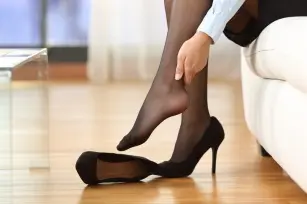
Leg swelling may indicate venous insufficiency, which patients most commonly refer to as varicose veins, or complain of tingling and numbness in the lower limbs. It happens that the cause of heaviness in the legs is heart disease. Learn about the most common causes of this ailment and how you can deal with them.
Leg swelling is most often associated with blood circulation disorders. This is because water seeps from the blood into the tissues through the vascular wall, resulting in swelling. It can take many forms – sometimes it is barely noticeable, but for example we feel that we cannot put on shoes, and other times it can be seen with the naked eye.
What are the symptoms of swollen legs?
Unfortunately, swelling of the legs is a symptom that can signal many diseases. It signals both problems with the circulatory system and hormonal disorders, so it is important to observe the accompanying symptoms: are the swellings symmetrical when they occur, are they accompanied by redness, soreness or higher body temperature.
- The most common cause of swollen legs is chronic venous insufficiency. This happens to 40% of women and 15% of men. Venous insufficiency results from stagnation of blood, long-term dilatation of venous vessels. This ailment is caused by the appearance of varicose veins, thrombosis, pressure on the iliac veins, deep vein obstruction. The most characteristic symptom is the increase in swelling in the evening after prolonged walking or standing. There is a tingling sensation, numbness, which disappears after lying down with the legs slightly raised.
- Other potential causes are: sodium retention, cardiovascular disease and excess water in the body if swelling in the ankles and calves occurs. They are symmetrical, pasty, appear in the evening or after prolonged walking and standing.
- Another cause there may be a venous thrombosis. In this case, thrombosis is unilateral, accompanied by bruising, pain, warming of the limb, tenderness. It is a very dangerous disease.
- Swelling of the legs can also be one of the effects kidney disease, menstruation, thyroid disease, or poor diet.
Leg swelling remedies
- Wear properly profiled shoes and avoid tight socks, high heels, tight stockings and trousers.
- If you work standing, it is good to often shift your body weight from one leg to the other, bend your knees, take breaks,
- Physical activity such as dancing, swimming, cycling and walking is conducive, as it promotes better blood and lymph circulation,
- Dehydration must be avoided, especially in summer. It is good to drink a lot of water, especially mineral water, about 2 liters a day. Dehydration favors the accumulation of water in the tissues “in reserve”.









